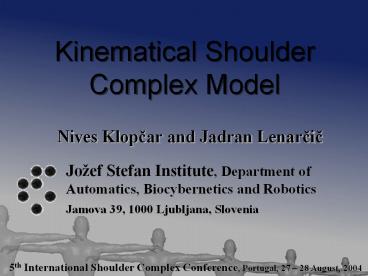Nives Klopcar and Jadran Lenarcic PowerPoint PPT Presentation
Title: Nives Klopcar and Jadran Lenarcic
1
Kinematical Shoulder Complex Model
- Nives Klopcar and Jadran Lenarcic
Jožef Stefan Institute, Department of Automatics,
Biocybernetics and Robotics Jamova 39, 1000
Ljubljana, Slovenia
5th International Shoulder Complex Conference,
Portugal, 27 28 August, 2004
2
1. Introduction
3
Biomechanical musculoskeletal model of human
upper limb (W. Maurel, 1996)
W. Maurel, D. Thalmann, P. Hoffmeyer, P. Beylot,
P. Gingins, P. Kalra, N. M. Thalmann, A
Biomechanical Musculoskeletal Model of Human
Upper Limb for Dynamic Simulation, Proc. 7th
Eurographics Workshop and Animation and
Simulaton, Wien, Sept. 1996.
1. Introduction
4
W. Maurel, D. Thalmann, P. Hoffmeyer, P. Beylot,
P. Gingins, P. Kalra, N. M. Thalmann, A
Biomechanical Musculoskeletal Model of Human
Upper Limb for Dynamic Simulation, Proc. 7th
Eurographics Workshop and Animation and
Simulaton, Wien, Sept. 1996.
1. Introduction
5
1. Introduction
6
Shoulder girdle measurements
- OPTOTRAK system
- active markers
- 5 male and 5 female
- (healthy, right-handed)
- shoulder girdle
- segment SG
- humerus segment GE
- humerus elevation
- 4 planes
- anterior/posterior
- bilateral/unilateral
2. Methods
7
Shoulder rhythm
BILATERAL
0.3 j,
j lt 0 jpr 0,
0 ltj lt 70 - 0.21 j 14.7,
70ltj
- 0.23 j, j
lt 0 jed 0, 0
ltj lt 30 0.31 j 9.3,
30ltj
3. Results
8
Shoulder rhythm
BILATERAL
0.3 j,
j lt 0 jpr 0,
0 ltj lt 70 - 0.21 j 14.7,
70ltj
- 0.23 j, j
lt 0 jed 0, 0
ltj lt 30 0.31 j 9.3,
30ltj
3. Results
9
Shoulder rhythm
BILATERAL
0.3 j,
j lt 0 jpr 0,
0 ltj lt 70 - 0.21 j 14.7,
70ltj
- 0.23 j, j
lt 0 jed 0, 0
ltj lt 30 0.31 j 9.3,
30ltj
3. Results
10
Shoulder girdle length changes
do SGf0 dRO SGf
3. Results
11
Shoulder girdle length changes
BILATERAL
dSG/do - 0.0064 jed 1
dSG/do 0.0028 jpr 1
3. Results
12
Shoulder girdle length changes
BILATERAL
dSG/do -1.9 . 10-5j 2 4 . 10-4j 1
3. Results
13
Shoulder girdle length changes
UNILATERAL
dSG/do -1.6 . 10-5j 2 3 . 10-4j 1
3. Results
14
Shoulder girdle angular motion
UNILATERAL
3. Results
15
Shoulder girdle angular motion
UNILATERAL
3. Results
16
Shoulder girdle angular motion
UNILATERAL
?je - 0.1 j 30
?jd 0.01 j - 14
?jp - 0.09 j 30
?jr 0.07 j - 26
3. Results
17
Shoulder girdle angular motion
UNILATERAL
?jed 2.1 . 10-3j 2 - 4 . 10-2j -14, 1.3 .
10-3j 2 - 3 . 10-2j 30
?jpr -1.2 . 10-3j 2 0.15 j - 26, 2.2 . 10-3j
2 0.15 j 30
3. Results
18
Kinematical shoulder complex model
rE Red Rpr T . rSG RA RF RR . rGE
Red Rot(y, jed) Rpr Rot(z, jpr) T Trans (x,
dSG/do) RA Rot(y, jA) RF Rot(x, jF) RR Rot(z,
jR)
rSG ( dSG, 0, 0)T rGE (0, 0, - dGE)T
dSG(H), dGE(H) H...subject height
D. A. Winter, Biomechanics and Motor Control of
Human Movement, A Wiley-Interscience Publication,
University of Waterloo, Canada, 1990.
3. Results
19
Elbow points calculation
rE Red Rpr T . rSG RA RF RR . rGE
- abduction/adduction jAm, jAM
- flexion/retroflexion jFm jA/3, jFM - jA/6
- internal/external rotation
- jRm7jA/9 - jF/9 2jAjF/810,
- jRM 4jA/9 5jF/9 5jAjF /810
- j acos (cos jA ? cos jF)
- - shoulder rhythm, shoulder girdle length
changes - jed, jpr and dSG/do
- - angular motion range
- Dje, Djd, Djp and Djr
Lenarcic, J., Umek, A., 1994. Simple model of
human arm reachable workspace. IEEE Transactions
on Systems, Man, and Cybernetics 24, 1239-1246.
3. Results
20
Conclusions
- shoulder girdle elevation and retraction is
- accompanying humeral elevation (shoulder
rhythm) - shoulder girdle changes length as a quadratic
function - during humeral elevation
- shoulder girdle angular motion range is the
biggest in - non-elevated humerus position, it lessens
during - humeral elevation and it halves in humerus
maximal - elevated position
- difference between bilateral and unilateral
humeral - elevation
- kinematical shoulder complex model
21
(No Transcript)

